Key takeaways:
- Community housing development should prioritize the human element, ensuring projects reflect the needs and desires of residents.
- Inclusive conversations foster trust and deepen community connections by actively listening to diverse perspectives.
- Creating safe environments for discussions, both physically and emotionally, enhances participant engagement and vulnerability.
- Utilizing various outreach methods helps engage underrepresented voices, revealing valuable insights and diverse perspectives on community issues.
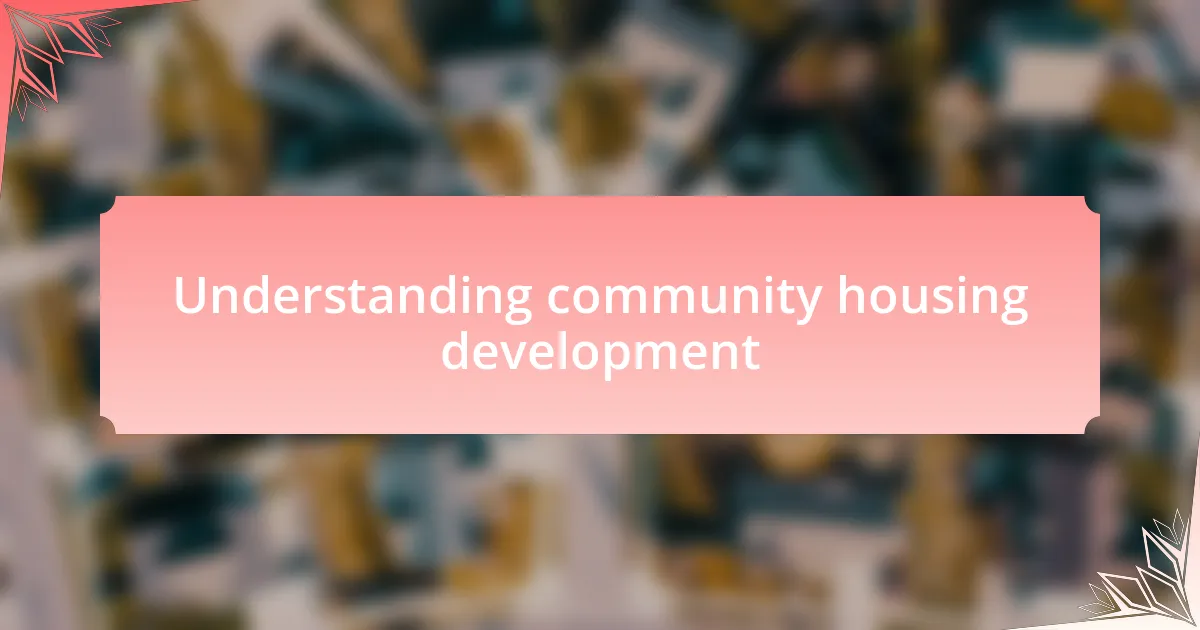
Understanding community housing development
Community housing development goes beyond merely constructing buildings; it’s about creating environments where relationships can flourish. I remember walking through a newly built complex, feeling the excitement of families moving in, each with unique stories and dreams. This made me ponder: how often do we truly consider the human element behind these developments?
Each project should reflect the needs and desires of the community it serves. I once participated in a local workshop where residents could voice their needs, revealing gaps between what developers assumed and what people actually wanted. It was a powerful reminder that listening is just as critical as planning.
Moreover, understanding community housing involves not only addressing physical needs but also fostering a sense of belonging. I’ve seen community gardens blossom where once there was just concrete, reminding me how essential it is to nurture spaces where people feel they truly belong. After all, isn’t that what home is really about?
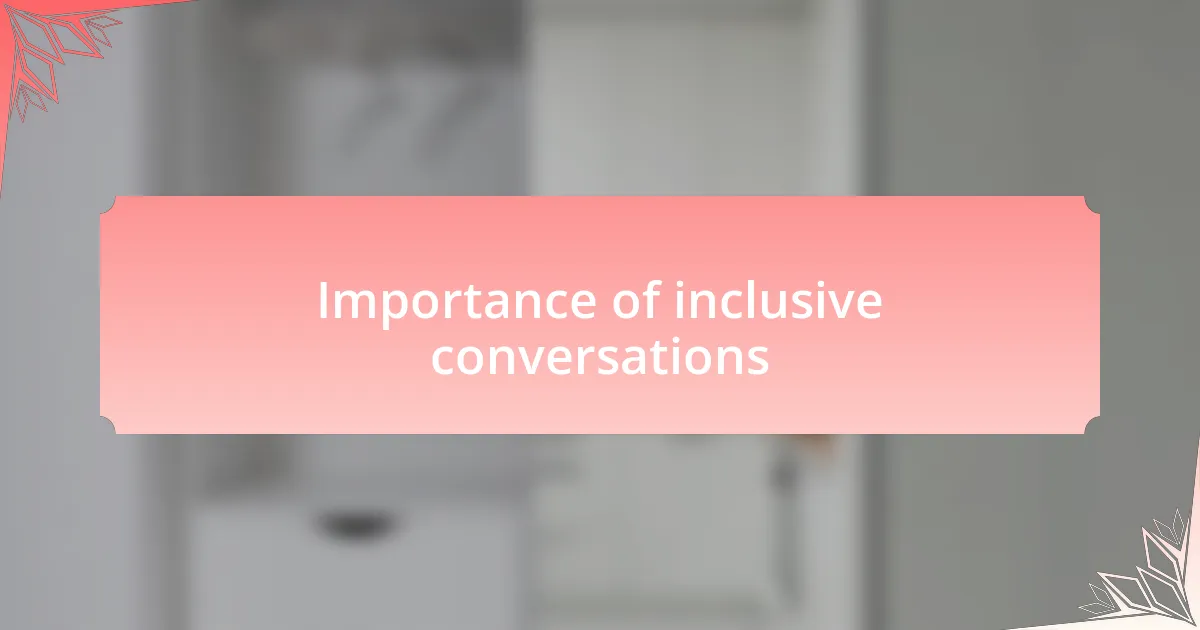
Importance of inclusive conversations
Inclusive conversations are paramount in community housing development because they ensure that every voice is heard. I’ve experienced moments in community meetings where listening to a quiet resident led to profound insights that shifted our entire project approach. When we prioritize inclusion, we not only honor individual perspectives but also pave the way for a more cohesive community.
Reflecting on my past engagements, I recall a particularly enlightening session where diverse viewpoints were shared, illuminating challenges I hadn’t considered. It struck me: how can we hope to build true community if we overlook the nuances of people’s experiences? Each comment or story shared adds depth to our understanding and ultimately enriches the development process.
Moreover, fostering an inclusive environment cultivates trust among residents and developers alike. In one project, I witnessed hesitant participants gradually open up as they realized their input was valued; the energy in the room shifted dramatically. This transformation underscored a vital truth: when people feel included, they are more likely to invest emotionally in the outcomes, creating a stronger, more unified community.
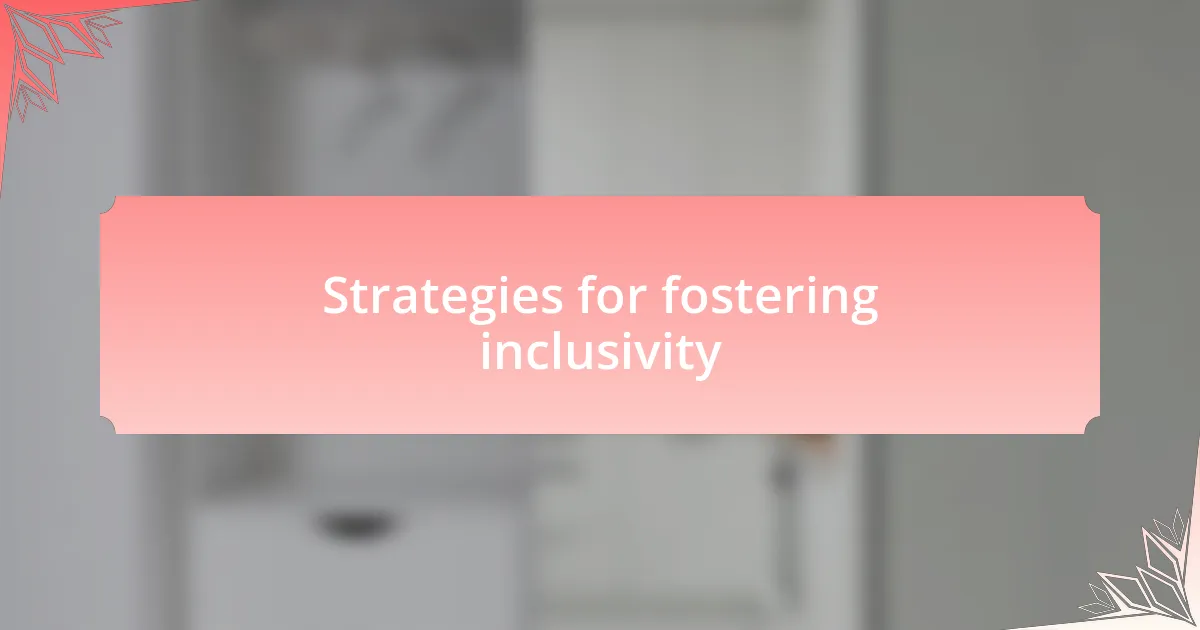
Strategies for fostering inclusivity
To foster inclusivity, one effective strategy is to actively encourage participation from all community members. I remember hosting a workshop designed specifically for those who often felt silenced or overlooked. By creating smaller breakout groups, quieter voices emerged, sharing experiences and ideas that added valuable layers to our plans. It was a powerful reminder that fostering an inclusive atmosphere sometimes means changing the format to ensure everyone has a chance to contribute.
Another approach I found valuable is to establish ground rules that prioritize respect and openness. In one session, we set clear expectations about valuing differing opinions and encouraged participants to share openly without fear of judgment. This helped transform the dynamic of the conversation, leading to rich discussions and deeper connections among residents. How can we expect growth if we aren’t willing to embrace discomfort? Creating a safe space for dialogue makes all the difference.
Lastly, regularly checking in with residents about the inclusivity of our conversations has proven essential. After a project update, I once circulated a simple survey asking whether everyone felt heard and included. The responses were eye-opening; some felt their concerns were still not adequately addressed. By soliciting this feedback, we not only identified areas for improvement but also demonstrated our commitment to a genuinely inclusive process. Isn’t it crucial to ensure that everyone walks away feeling valued and heard?
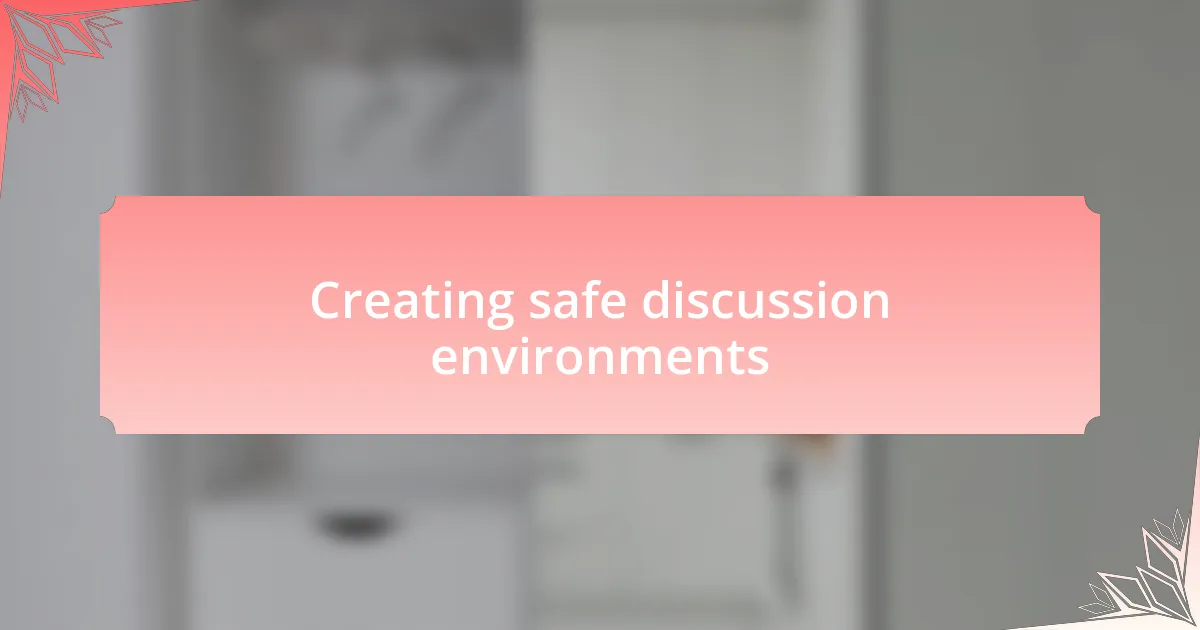
Creating safe discussion environments
Creating a safe discussion environment begins with the physical space where conversations take place. I recollect a time when we chose a cozy community center room, arranging the seating in a circle instead of traditional rows. This simple shift fostered a sense of equality; participants could look at one another, making it easier to engage authentically. Have you ever noticed how the layout can change the entire tone of a conversation?
Emotional safety is equally vital. I often share the story of a participant in one of our workshops who expressed hesitance due to past experiences of being dismissed. By encouraging vulnerability and sharing my own struggles, I saw a remarkable transformation as others began to open up. It reinforces the idea that leading by example can break down barriers; how can we establish connections if we don’t first show our humanity?
Lastly, I find that inviting diverse perspectives to initiate dialogue can set the stage for trust. During one collaborative session, I asked a resident to share her unique journey about finding housing, and it sparked a deeply resonant discussion. How often do we miss opportunities to learn from those around us? By valuing diverse stories and backgrounds, we create a tapestry of understanding that enriches our conversations and fosters a truly inclusive environment.
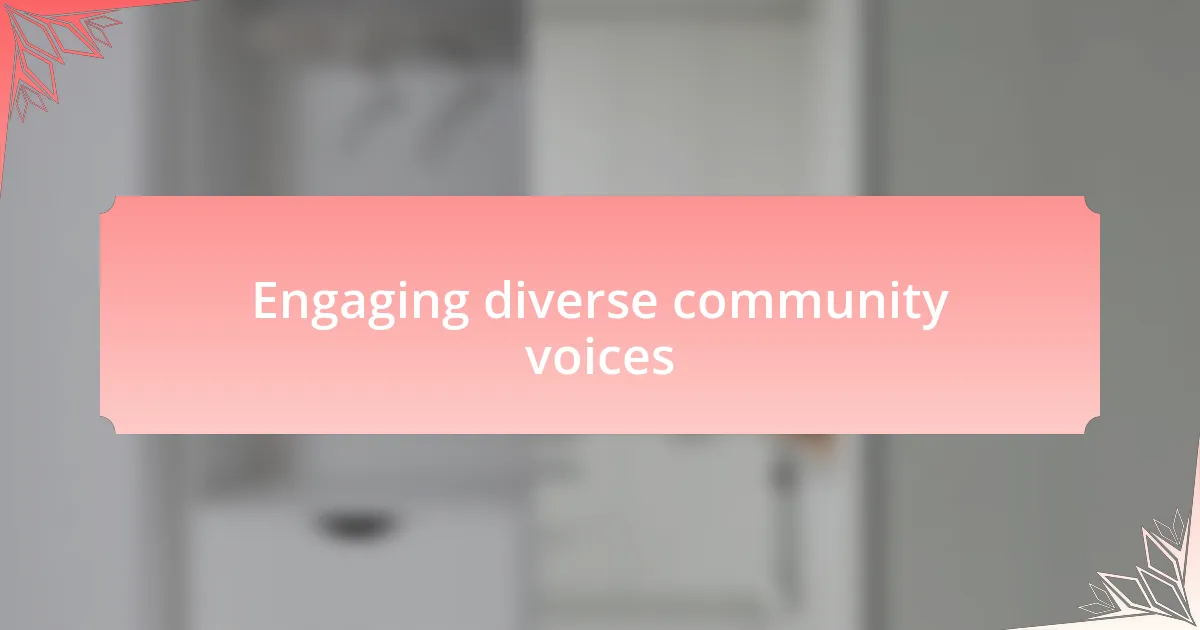
Engaging diverse community voices
Engaging diverse community voices involves more than just bringing people together; it requires actively listening and validating their experiences. I remember organizing a forum where each participant shared their story regarding housing challenges. One individual, whose family had faced significant obstacles, moved the group to tears. Why do personal stories carry such weight? Because they connect us on a human level, allowing us to see beyond statistics and appreciate the real-life implications of community issues.
Creating an atmosphere of inclusion means acknowledging every voice, even those that might seem quieter at first. In a recent project, I encouraged a shy resident to share her perspective during a discussion about community resources. She initially hesitated, but once she spoke about her desire for accessible services for older adults, the feedback from others was overwhelmingly supportive. It reinforced my belief that everyone has valuable contributions; how often have we overlooked those who need just a bit of encouragement to find their voice?
Moreover, it’s crucial to use various platforms to engage different demographics within the community. I once utilized social media to invite younger residents to share their housing experiences. The responses poured in, revealing insights I hadn’t anticipated, especially about the unique challenges they face in finding affordable options. Isn’t it fascinating how expanding our outreach can illuminate forgotten perspectives? By harnessing diverse voices through multiple channels, we can ensure that our conversations reflect the rich tapestry of the community we serve.
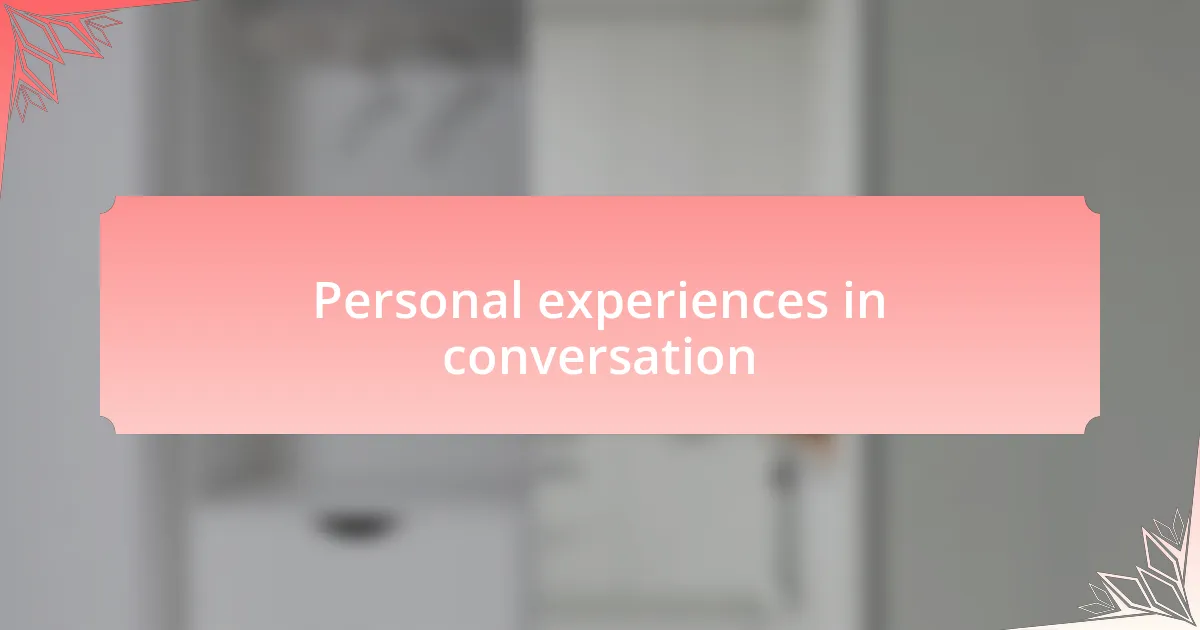
Personal experiences in conversation
Every conversation I’ve facilitated has its own unique flavor, shaped by the individuals involved. One memorable moment happened during a small group discussion when a resident shared her experience navigating the complexities of securing affordable housing after a job loss. As she recounted her journey, I noticed tears in her eyes and those of the others in the room. It struck me how vulnerability can bond us, making us more empathetic and eager to support one another. Have you ever noticed how sharing a struggle can unify a group, shifting the atmosphere from distant to connected?
In another instance, I found myself sitting beside a neighbor who typically stayed silent in larger gatherings. I decided to engage him one-on-one before the meeting, asking what issues weighed heavily on his mind. It turned out that he had a wealth of knowledge about local zoning laws that could impact our housing projects. I realized that meaningful conversation can often begin in the quiet spaces, where individuals may feel safer to express themselves. How often do we miss out on important insights when we overlook the quieter participants in our discussions?
One of the most rewarding experiences came from hosting an intergenerational dialogue that paired younger and older residents. We all sat in a circle, and I noticed a young man nervously preparing to speak. When he finally did, he addressed the older generation about the importance of fostering community gardens. It was touching to see different perspectives collide, creating a space for mutual respect and understanding. It left me wondering: how can we harness these valuable conversations to inspire action that meets everyone’s needs?
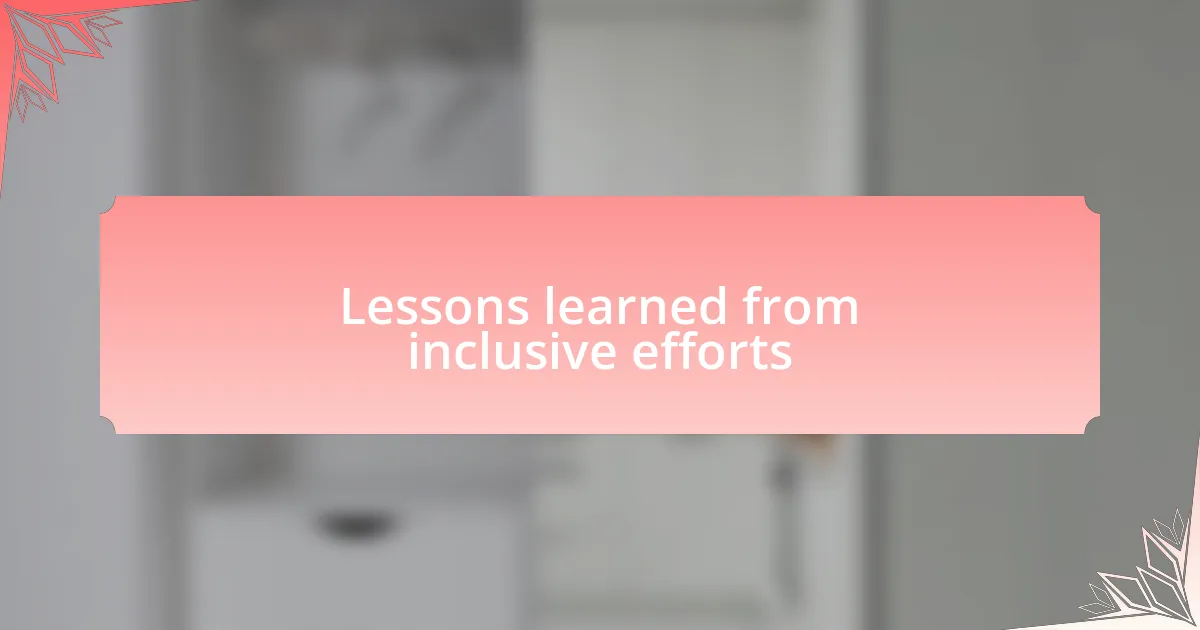
Lessons learned from inclusive efforts
In my journey towards fostering inclusive conversations, one key lesson I learned is the power of active listening. During a discussion about housing challenges, a participant paused mid-sentence, seemingly unsure of how to continue. Instead of rushing to fill the silence, I maintained eye contact and nodded encouragingly. That quiet moment allowed her to gather her thoughts and ultimately share a profound insight about the need for more mental health resources in our housing developments. Have you noticed how silence can sometimes speak louder than words?
Another realization came from acknowledging diverse communication styles within the group. While some participants thrived in open debates, others preferred sharing their thoughts in smaller, more intimate settings. I remember facilitating a workshop where we employed both formats, which ultimately led to richer contributions. It dawned on me that accommodating different preferences can inspire deeper engagement and more varied perspectives. How often do we box ourselves into one style of conversation and miss out on the richness that variety can bring?
One particularly striking experience highlighted the importance of setting a tone of trust. While co-hosting a discussion focused on community safety, I adopted a casual, inviting demeanor. Participants began to share personal stories of their experiences with crime and resilience. As tears were shed and laughter erupted in equal measure, a sense of safety enveloped the room. I learned that when people feel secure, they are more willing to open up and contribute genuinely to the dialogue. What would it take for us to create that kind of environment consistently?